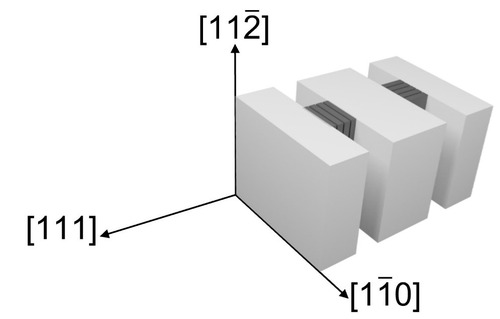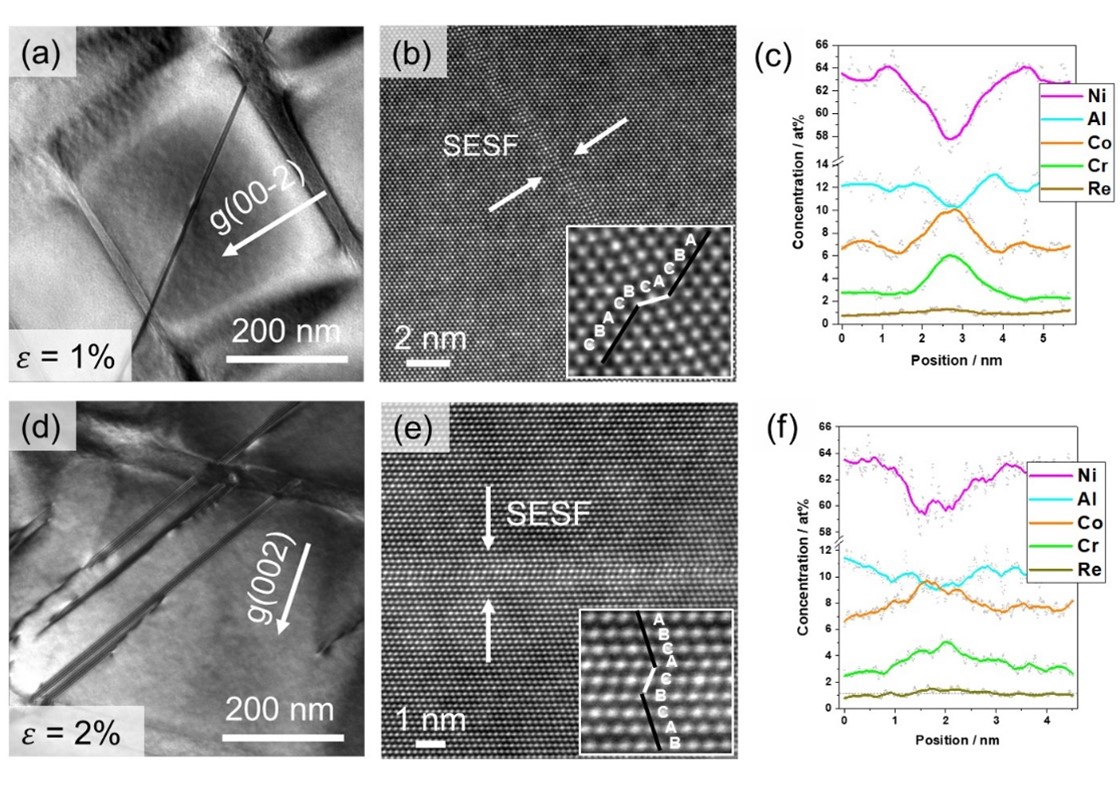Segregation to creep-induced planar faults in Ni-base SX superalloys
Contact Zhongmin Long, Yolita Eggeler
Ni-base single-crystal (SX) superalloys find application in turbine blades for gas engines due to the high-temperature and high-stress strength originating from the coherent γ/γ' microstructure [1]. It is well-known at sufficiently high stresses, two 1/2<101> dislocation families with different Burgers vectors can react and dissociate into two partial dislocations in γ channels. This allows the leading 1/3 [-1-12] Shockley partial dislocation continuously gliding on {111} planes to cut into γ' precipitates where they create planar faults [2-4]. We study the segregation behaviours of alloying elements across the planar faults by performing the double creep shear experiments [5] with shear system [11-2] (111), as shown in Fig 1. The slip system [11-2] (111) with the highest Schmid factor of 1 is intentionally activated where the resolved shear stress is exactly equal to loading stress. The creep-deformed specimens are interrupted after 1% and 2% shear strain under 250 MPa at 750°C. The resulting microstructure is investigated using conventional transmission electron microscopy (TEM), analytical scanning TEM (STEM) with energy-dispersive X-ray spectroscopy (EDXS) focusing on structural, physical, and chemical details of the local deformation

Fig. 2 presents the specimen perpendicular to the (111) plane with the [1-10] direction parallel to the electron beam. Numerous stacking faults (SF) are observed after 1% and 2% creep strains. Fringe contrasts under two-beam conditions indicate inclined stacking faults shown in Fig 2a and 2d, where the 2% strain sample has more planar faults within one γ' precipitate indicating a higher density of planar faults in the 2% sample. High-resolution STEM micrographs illustrate the superlattice extrinsic nature of stacking faults (SESF) in the 1% and 2% strained samples, see Fig 2b and 2e. The chemical distributions across SESF are measured by EDXS and the corresponding concentration profiles of 1% and 2% samples are shown in Fig. 2c and 2f respectively. Both samples show almost similar segregation tendencies, which is that γ forming elements Cr, Co, and Re are enriched across the SESF while γ' alloying elements Ni and Al are depleted. For these measurements, all microscope parameters and sample thickness for EDXS analysis are kept the same to quantitatively find out how creep strain and time affect the evolution of segregation.

References
[1] R.C. Reed, The superalloys: fundamentals and applications, Cambridge university press., 2006.
[2] Y.M. Eggeler, J. Muller, M.S. Titus, A. Suzuki, T.M. Pollock, E. Spiecker, Planar defect formation in the gamma' phase during high temperature creep in single crystal CoNi-base superalloys, Acta Materialia 113 (2016) 335-349.
[3] Y.M. Eggeler, M.S. Titus, A. Suzuki, T.M. Pollock, Creep deformation-induced antiphase boundaries in L1 2 -containing single-crystal cobalt-base superalloys, Acta Materialia 77 (2014) 352-359.
[4] Y.M. Eggeler, K.V. Vamsi, T.M. Pollock, Precipitate Shearing, Fault Energies, and Solute Segregation to Planar Faults in Ni-, CoNi-, and Co-Base Superalloys, Annual Review of Materials Research 51(1) (2021) 209-240.
[5] D. Bürger, A. Dlouhý, K. Yoshimi, G. Eggeler, On the stress and temperature dependence of low temperature and high stress shear creep in Ni-base single crystal superalloys, Materials Science and Engineering: A 795 (2020).
